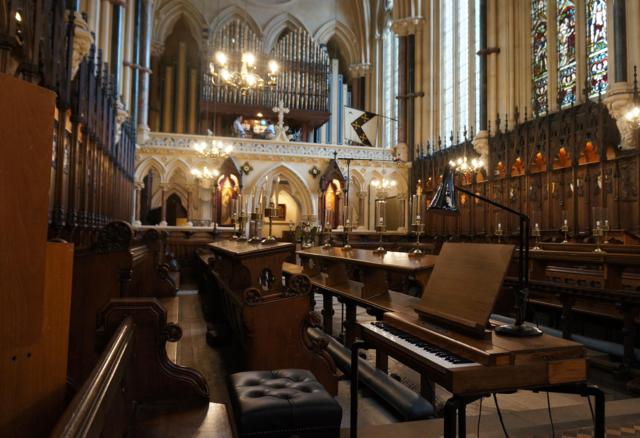Audio Examples of HW
Introduction
A year ago I was asked to give an organ-themed talk in a village in Dorset. I chose to outline the development of the use of the organ in liturgy through the ages in various countries, and I illustrated the talk with examples recorded by myself on my Hauptwerk organ using a range of appropriate sample sets.
Most of the examples below were recorded for that talk.
I am not a good organist, and I apologise for the lumpy playing; but people seemed to enjoy hearing the different examples.
Organ voices
These recordings were used simply to illustrate a range of different organ voices, and were all recorded using the sample set of Hereford Cathedral organ (built by Father Willis). I talked a little about the different forms of the pipes.
Open Diapason
Principal
Fifteenth
Chorus to mixture
Flute
Tierce registration
String
Celeste
Dulciana
Trumpet
Tuba
Bombarde (32')
Early Lutheran
The first section of my talk covered early Lutheran liturgy, and I used music by Scheidt and Bach.
The Scheidt pieces were played using a modern organ built in the old German style. It is in the South of France, and was made by a Swiss organ builder who lives in Spain!
Scheidt - Aus tiefer Not schrei ich zu dir
Scheidt - Magnificat (VIII Ton)
These Bach chorale preludes are played on a Dutch organ originally built in 1719, and thus contemporary with Bach himself.
Bach - BWV 961, Wer nur den lieben Gott laesst walten
Bach - BWV 728, Jesus, meine Zuversicht
This Bach chorale prelude was not for the talk, and is played using an English village organ built by Father Willis. It is played very fast, which is an interpretation I was experimenting with at the time.
French Organ Masses
The reign of Louis XIV saw the peak of a peculiarly (though not solely) French Catholic phenomenon - the organ mass. Alternate lines of the ordinary were chanted by the choir and played by the organ. The style of the organ lines became highly conventional, with specific musical styles and registrations always being used at the same places; the second couplet of the Kyrie was always a fugue played on the trumpet stop, for instance. The French organs of that time were also very distinctive, and provided a standardised set of registrations for use in the organ masses.
Francois Couperin wrote two organ masses which are the best known and most performed examples. This first piece is from the Mass for Parishes, and has the plainchant melody picked out using the pedal trumpets. The organ used was built in 1714 in Northern France, and is one of the most perfect surviving examples of the type.
The next pieces are taken from Couperin's Mass for Convents. This is clearly written for a smaller organ, as the pedal trumpet registration of the piece above is nowhere called for, but most of the other "standard" registrations are specified as usual. The organ I used was built rather later, in 1775. It is a very large organ, but these pieces can still be played on it, of course.
Couperin - Kyrie I Plein Jeu
Couperin - Kyrie II Fugue on the trumpet
For comparison, here are commercial recordings of the same two pieces played on the same organ. Of course, the recording engineers have used different setups, and the playing is quite different (!), with somewhat different registrations, but you should be able to get a sense of how Hauptwerk is reproducing the effect of being in the cathedral itself. The pitch is slightly different because I had used Hauptwerk to bring the pitches of all my examples to the same level for the comfort of the audience.
Couperin - Kyrie I Plein Jeu
Couperin - Kyrie II Fugue on the trumpet
Finally, here is an example, still from the Mass for Convents, and on the same organ, which I didn't use in the talk because the playing is too self-indulgent and undisciplined - but the sound is beautiful!
Couperin - Elevation Tierce en taille
French Masses with Two Organs
At the end of the nineteenth century, several French composers wrote settings of the mass for choir and two organs. The great Parisian churches have, in addition to the grand organ at the West end used for voluntaries and congegational accompaniment, a smaller organ in the chancel for accompanying the choir. This recording of the Agnus Dei from Vierne's Messe Solonnelle was made in the chapel of Exeter College, Oxford, using my Hauptwerk-based chamber organ as the choir organ; the photo below shows the chamber organ, with the main organ in the background.

English
At this point my talk was wearing rather thin. The last two examples are of eighteenth century English organ music. As none of the few surviving English organs of that period have yet been sampled for Hauptwerk, I used the North French organ that the first Couperin piece was played on, as the styles of these organs had a lot in common (though the English ones had no pedals and were generally smaller). The first of these pieces was played at my first wedding; the second I once played (on a small contemporaneous organ) in a village church for the then Bishop of Oxford to process in to.
Stanley - Voluntary, vol II, no 5
Stanley - Voluntary, vol III, no 10, opening
Finally, another example not for the talk. This was recorded to be played at a funeral. It illustrates the flexibility of Hauptwerk, because it was played on a single manual. Hauptwerk was set up to play the top line on a separate solo stop (in the second verse), and to play the bottom line on pedal stops. The organ is an ordinary mid-sized Victorian parish church organ in a suburb of Birmingham.

